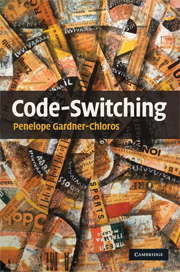Book contents
- Frontmatter
- Contents
- Acknowledgements
- Transcription conventions
- 1 Introduction
- 2 Code-switching and language contact
- 3 Social factors in code-switching
- 4 Code-switching in conversation
- 5 Grammatical aspects of code-switching
- 6 Psycholinguistic approaches
- 7 Acquiring code-switching: code-switching in children (and L2 learners)
- 8 Conclusions
- Appendix
- Bibliography
- Index
7 - Acquiring code-switching: code-switching in children (and L2 learners)
Published online by Cambridge University Press: 10 February 2010
- Frontmatter
- Contents
- Acknowledgements
- Transcription conventions
- 1 Introduction
- 2 Code-switching and language contact
- 3 Social factors in code-switching
- 4 Code-switching in conversation
- 5 Grammatical aspects of code-switching
- 6 Psycholinguistic approaches
- 7 Acquiring code-switching: code-switching in children (and L2 learners)
- 8 Conclusions
- Appendix
- Bibliography
- Index
Summary
Introduction
As was the case in earlier chapters, the preference for an interdisciplinary approach makes it necessary to be highly selective within the various contributing research traditions. The considerable literature on both monolingual and bilingual child language acquisition which is relevant to the issues discussed here, cannot be summarized in toto and the reader is referred for further background information to Fletcher and MacWhinney (1995), Bialystok (1991) and de Houwer (1995). As in the psycholinguistic studies, a number of issues addressed in the literature on bilingual children have a bearing on CS, whether or not children's CS is the topic of the research as such.
One such example is that of the critical period hypothesis, on which there is a large number of publications. This hypothesis states that there is a “critical period”, generally thought to end at puberty, during which children can acquire full native competence in their mother tongue. Children who suffer accidents, illnesses or deprivations affecting their language development prior to this critical stage are generally able to recover full linguistic functioning, whereas those who suffer such traumas beyond this point may never be able to do so. Similarly, second or third languages can usually be acquired with full native-like competence by young children, but there is evidence that this ability also declines with age, i.e. there is an – admittedly less crucial – critical period for acquiring further languages as well (Hamers and Blanc, 2000; Johnson and Newport, 1989).
- Type
- Chapter
- Information
- Code-switching , pp. 142 - 164Publisher: Cambridge University PressPrint publication year: 2009



